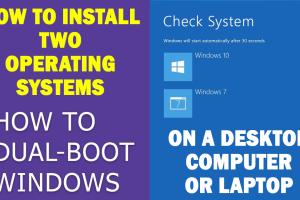Ultimate Dual Boot Guide: Install Two Operating Systems on Your PC

-
Quick Links:
- Introduction
- What is Dual Booting?
- Benefits of Dual Booting
- Preparing for Dual Boot
- Steps to Install Dual Boot
- Common Issues and Solutions
- Case Study: Dual Booting for Developers
- Expert Insights on Dual Booting
- FAQs
Introduction
In an era where multiple operating systems coexist, the ability to dual boot can transform your computing experience. Whether you're a gamer who needs Windows for gaming and Linux for development, or a user wanting to explore diverse environments, dual booting is a practical solution. This guide will walk you through everything you need to know about installing two operating systems on your PC.
What is Dual Booting?
Dual booting refers to the installation of two separate operating systems on a single computer, allowing the user to choose which OS to load at startup. This setup can be beneficial for running applications that are exclusive to one OS or for testing purposes.
Benefits of Dual Booting
- Flexibility: Users can switch between different operating systems based on their needs.
- Resource Optimization: Dual booting can improve performance since each OS runs independently without resource sharing.
- Testing and Development: Developers can test applications across various platforms.
- Learning Opportunities: Users can explore new operating systems without needing separate hardware.
Preparing for Dual Boot
Before you dive into dual booting, several preparatory steps are essential:
1. Backup Your Data
Always ensure that your important data is backed up. Dual booting involves partitioning your hard drive, which could lead to data loss if something goes wrong.
2. Check System Requirements
Verify the system requirements for both operating systems. Ensure your hardware meets the needs for performance and compatibility.
3. Create Installation Media
Download the ISO files for the operating systems you want to install and create bootable USB drives or DVDs for installation.
4. Partition Your Hard Drive
You will need to create a dedicated partition for the second operating system. This can be done using disk management tools included in your current OS.
Steps to Install Dual Boot
Step 1: Create a Partition
Use tools like Windows Disk Management or GParted in Linux to shrink the existing partition and create space for the new OS.
Step 2: Install the First Operating System
If you haven't already, install the first operating system on the primary partition. Follow the standard installation procedure for your OS.
Step 3: Boot from Installation Media
Insert the installation media for the second OS and reboot your PC. Ensure that the BIOS/UEFI settings are configured to boot from the USB or DVD drive.
Step 4: Install the Second Operating System
During the installation process, select the partition you created earlier. Ensure you do not overwrite the first OS.
Step 5: Configure the Bootloader
Once the installation is complete, your computer will likely default to the last installed OS. Configure the bootloader (like GRUB for Linux) to recognize both systems.
Step 6: Reboot and Test
Reboot your PC and verify that the boot menu allows you to select between the two operating systems. Test both to ensure they function correctly.
Common Issues and Solutions
While dual booting can be straightforward, users may encounter some challenges. Here are common issues and their solutions:
- Bootloader Problems: If one OS fails to appear in the boot menu, you may need to reinstall or reconfigure the bootloader.
- Partition Errors: Ensure that partitions are formatted correctly for the respective operating systems.
- Driver Issues: Sometimes, hardware may not work correctly on one OS. Ensure you have the latest drivers installed.
Case Study: Dual Booting for Developers
A software developer, Sarah, needed both Windows and Linux for her projects. By dual booting, she maintained a stable Windows environment for her gaming and design work while using Linux for programming and testing. Sarah reported a 30% increase in productivity as she could seamlessly switch between environments without needing separate machines. Her experience highlights the practical benefits of dual booting for professionals.
Expert Insights on Dual Booting
According to tech expert John Doe, “Dual booting is an excellent way to maximize the utility of your hardware. It allows users to experience the best of both worlds without investing in additional devices.” His insights emphasize the value of dual booting in a multi-faceted digital landscape.
FAQs
1. Is dual booting safe?
Yes, dual booting is safe as long as you follow the correct procedures and back up your data.
2. Can I dual boot Windows and Linux?
Absolutely! Many users dual boot Windows and Linux for flexibility in software development and gaming.
3. Will dual booting slow down my PC?
Not necessarily. Each OS uses its own partition, and performance depends on hardware specifications.
4. What happens if I delete one OS?
If you delete one OS, you may need to repair the bootloader to access the remaining operating system.
5. Can I dual boot more than two operating systems?
Yes, it is possible to dual boot multiple operating systems, but it requires careful partitioning and bootloader management.
6. How do I switch between operating systems?
You can switch between operating systems from the boot menu that appears during startup.
7. Do I need separate licenses for each OS?
Yes, you must have a valid license for each operating system you install.
8. Can dual booting affect my hardware warranty?
Generally, dual booting should not affect your hardware warranty unless you make unsupported modifications.
9. What is a bootloader?
A bootloader is a program that loads the operating system into memory. GRUB is a common bootloader for Linux systems.
10. How do I recover if the installation goes wrong?
You can use recovery tools or installation media to repair or reinstall the operating systems.